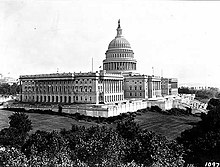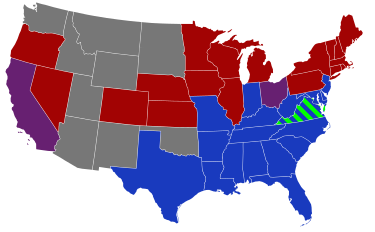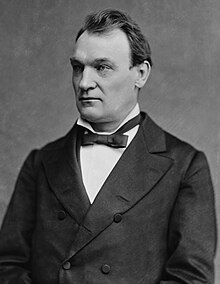| 50th United States Congress | |
|---|---|
49th ← →
51st | |

United States Capitol (1906) | |
March 4, 1887 – March 4, 1889 | |
| Members | 76 senators 325 representatives 8 non-voting delegates |
| Senate majority | Republican |
| Senate President | Vacant |
| House majority | Democratic |
| House Speaker | John G. Carlisle (D) |
| Sessions | |
| 1st: December 7, 1887 – October 20, 1888 2nd: December 3, 1888 – March 3, 1889 | |
The 50th United States Congress was a meeting of the legislative branch of the United States federal government, consisting of the United States Senate and the United States House of Representatives. It met in Washington, D.C. from March 4, 1887, to March 4, 1889, during the third and fourth years of Grover Cleveland's first presidency. The president vetoed 212 pieces of legislation, the greatest number in a single session of Congress.
The apportionment of seats in the House of Representatives was based on the 1880 United States census. The Senate had a Republican majority, and the House had a Democratic majority.
Major events
Major legislation
- October 8, 1888: Chinese Exclusion Act ( Scott Act)
- January 14, 1889: Nelson Act of 1889
- February 22, 1889: Enabling Act of 1889, Sess. 2, ch. 180, 25 Stat. 676
Party summary
The count below identifies party affiliations at the beginning of the first session of this Congress, and includes members from vacancies and newly admitted states, when they were first seated. Changes resulting from subsequent replacements are shown below in the "Changes in membership" section.
Senate
| Party (shading shows control) |
Total | Vacant | |||
|---|---|---|---|---|---|
|
Democratic (D) |
Readjuster (RA) |
Republican (R) |
|||
| End of previous congress | 34 | 2 | 40 | 76 | 0 |
| Begin | 35 | 1 | 38 | 74 | 2 |
| End | 37 | 76 | 0 | ||
| Final voting share | 48.7% | 1.3% | 50.0% | ||
| Beginning of next congress | 37 | 0 | 39 | 76 | 0 |
House of Representatives
| Party (shading shows control) |
Total | Vacant | ||||||
|---|---|---|---|---|---|---|---|---|
|
Democratic (D) |
Labor (L) |
Greenback (GB) |
Independent (I) |
Independent Republican (IR) |
Republican (R) |
|||
| End of previous congress | 180 | 0 | 1 | 0 | 0 | 138 | 319 | 5 |
| Begin | 168 | 2 | 1 | 1 | 2 | 150 | 324 | 1 |
| End | 167 | 151 | ||||||
| Final voting share | 51.5% | 0.6% | 0.3% | 0.3% | 0.6% | 46.6% | ||
| Beginning of next congress | 160 | 0 | 0 | 0 | 0 | 164 | 324 | 1 |
Leadership
Senate
- President: Vacant
- President pro tempore: John J. Ingalls (R)
- Republican Conference Chairman: George F. Edmunds
- Democratic Caucus Chairman: James B. Beck
House of Representatives
- Speaker: John G. Carlisle (D)
- Minority Leader: Thomas B. Reed
- Democratic Caucus Chairman: Samuel S. Cox
- Republican Conference Chairman: Joseph Gurney Cannon
- Democratic Campaign Committee Chairman: John E. Kenna
Members
Senate
Senators were elected by the state legislatures every two years, with one-third beginning new six-year terms with each Congress. Preceding the names in the list below are Senate class numbers, which indicate the cycle of their election. In this Congress, Class 1 meant their term began in this Congress, requiring reelection in 1892; Class 2 meant their term ended in this Congress, requiring reelection in 1888; and Class 3 meant their term began in the last Congress, requiring reelection in 1890.
House of Representatives
The names of members of the House of Representatives are preceded by their district numbers.
Changes in membership
The count below reflects changes from the beginning of this Congress.
Senate
- Replacements: 1
- Democratic: no net change
- Republican: no net change
- Liberal Republican: 1 seat net loss
- Deaths: 0
- Resignations: 1
- Interim appointments: 1
- Total seats with changes: 2
| State (class) |
Vacated by | Reason for vacancy | Subsequent | Date of successor's installation |
|---|---|---|---|---|
|
West Virginia (1) |
Vacant | Filled vacancy in term. | Charles J. Faulkner (D) | May 5, 1887 |
|
Florida (1) |
Vacant | Filled vacancy in term. | Samuel Pasco (D) | May 19, 1887 |
|
New Hampshire (2) |
Person C. Cheney (R) | Successor was elected June 14, 1887 | William E. Chandler (R) | June 14, 1887 |
House of Representatives
- Replacements: 8
- Democratic: no net change
- Republican: no net change
- Deaths: 4
- Resignations: 5
- Contested election: 0
- Total seats with changes: 8
| District | Vacated by | Reason for change | Successor | Date successor seated |
|---|---|---|---|---|
| New York 25th | Vacant | Rep. Frank Hiscock resigned during previous congress | James J. Belden (R) | November 8, 1887 |
| Texas 2nd | John H. Reagan (D) | Resigned March 4, 1887, after being elected to the U.S. Senate | William H. Martin (D) | November 4, 1887 |
| Louisiana 6th | Edward W. Robertson (D) | Died August 2, 1887 | Samuel M. Robertson (D) | December 5, 1887 |
| New York 19th | Nicholas T. Kane (D) | Died September 14, 1887 | Charles Tracey (D) | November 8, 1887 |
| Michigan 11th | Seth C. Moffatt (R) | Died December 22, 1887 | Henry W. Seymour (R) | February 14, 1888 |
| New York 1st | Perry Belmont (D) | Resigned December 1, 1888, after being appointed Minister to Spain | Vacant until next Congress | |
| Indiana 1st | Alvin P. Hovey (R) | Resigned January 17, 1889, after being elected
Governor of Indiana. New member elected January 29, 1889 and seated February 6, 1889. [1] |
Francis B. Posey (R) | February 6, 1889 |
| Missouri 4th | James N. Burnes (D) | Died January 23, 1889. New member elected February 19, 1889 and seated February 25, 1889. [1] |
Charles F. Booher (D) | February 25, 1889 |
Committees
Lists of committees and their party leaders for members of the House and Senate committees can be found through the Official Congressional Directory at the bottom of this article. The directory after the pages of terms of service lists committees of the Senate, House (Standing with Subcommittees, Select and Special) and Joint and, after that, House/Senate committee assignments. On the committees section of the House and Senate in the Official Congressional Directory, the committee's members on the first row on the left side shows the chairman of the committee and on the right side shows the ranking member of the committee.
Senate
|
|
|
House of Representatives
- Accounts (Chairman: Frank T. Shaw; Ranking Member: James O'Donnell)
- Agriculture (Chairman: William H. Hatch; Ranking Member: Justin R. Whiting)
- Alcoholic Liquor Traffic (Select) (Chairman: James E. Campbell; Ranking Member: N/A)
- American Ship building (Select)
- Appropriations (Chairman: Samuel J. Randall; Ranking Member: Joseph G. Cannon)
- Banking and Currency (Chairman: Beriah Wilkins; Ranking Member: Luther F. McKinney)
- Claims (Chairman: S. W. T. Lanham; Ranking Member: John Lynch)
- Coinage, Weights and Measures (Chairman: Richard P. Bland; Ranking Member: Norman Hall)
- Commerce (Chairman: Martin L. Clardy; Ranking Member: James Phelan Jr.)
- District of Columbia (Chairman: John J. Hemphill; Ranking Member: Robert J. Vance)
- Education (Chairman: Allen D. Candler; Ranking Member: John B. Penington)
- Elections (Chairman: Charles F. Crisp; Ranking Member: Littleton W. Moore)
- Enrolled Bills (Chairman: Spencer O. Fisher; Ranking Member: Constantine B. Kilgore)
- Expenditures in the Interior Department (Chairman: Thomas R. Hudd; Ranking Member: Charles N. Brumm)
- Expenditures in the Justice Department (Chairman: William H. H. Cowles; Ranking Member: Albert C. Thompson)
- Expenditures in the Navy Department (Chairman: William L. Scott; Ranking Member: Jacob Romeis)
- Expenditures in the Post Office Department (Chairman: Alexander M. Dockery; Ranking Member: Charles E. Brown)
- Expenditures in the State Department (Chairman: Leopold Morse; Ranking Member: Louis E. Atkinson)
- Expenditures in the Treasury Department (Chairman: Joseph Wheeler; Ranking Member: John M. Farquhar)
- Expenditures in the War Department (Chairman: Polk Laffoon; Ranking Member: William Warner)
- Expenditures on Public Buildings (Chairman: Timothy J. Campbell; Ranking Member: Seth L. Milliken)
- Foreign Affairs (Chairman: James B. McCreary; Ranking Member: James S. Cothran)
- Indian Affairs (Chairman: Samuel W. Peel; Ranking Member: Silas Hare)
- Invalid Pensions (Chairman: Courtland C. Matson; Ranking Member: Thomas L. Thompson)
- Judiciary (Chairman: David B. Culberson; Ranking Member: John D. Stewart)
- Labor (Chairman: John J. O'Neill; Ranking Member: Edward Burnett)
- Levees and Improvements of the Mississippi River (Chairman: Thomas C. Catchings; Ranking Member: Samuel M. Robertson)
- Library (Chairman: William G. Stahlnecker; Ranking Member: Charles O'Neill)
- Manufactures (Chairman: Henry Bacon; Ranking Member: Frank C. Bunnell)
- Merchant Marine and Fisheries (Chairman: Poindexter Dunn; Ranking Member: John L. MacDonald)
- Mileage (Chairman: John H. Rogers; Ranking Member: James J. Belden)
- Military Affairs (Chairman: Richard W. Townshend; Ranking Member: Samuel S. Yoder)
- Militia (Chairman: William McAdoo; Ranking Member: Francis B. Spinola)
- Mines and Mining (Chairman: Charles T. O'Ferrall; Ranking Member: Marion Biggs)
- Naval Affairs (Chairman: Hilary A. Herbert; Ranking Member: Joseph Abbott)
- Pacific Railroads (Chairman: Joseph H. Outhwaite; Ranking Member: Miles T. Granger)
- Patents (Chairman: James B. Weaver; Ranking Member: Robert J. Vance)
- Pensions (Chairman: Archibald M. Bliss; Ranking Member: John E. Russell)
- Printing (Chairman: James D. Richardson; Ranking Member: John A. Hiestand)
- Private Land Claims (Chairman: John M. Glover; Ranking Member: Louis C. Latham)
- Post Office and Post Roads (Chairman: James H. Blount; Ranking Member: Alfred Rowland)
- Public Buildings and Grounds (Chairman: Samuel Dibble; Ranking Member: Charles E. Hogg)
- Public Lands (Chairman: William S. Holman; Ranking Member: John L. MacDonald)
- Railways and Canals (Chairman: Robert H. M. Davidson; Ranking Member: Henry H. Carlton)
- Revision of Laws (Chairman: William C. Oates; Ranking Member: Charles E. Hogg)
- Rivers and Harbors (Chairman: Newton C. Blanchard; Ranking Member: Thomas L. Thompson)
- Rules (Chairman: John G. Carlisle; Ranking Member: Thomas B. Reed)
- Standards of Official Conduct
- Territories (Chairman: William M. Springer; Ranking Member: Melbourne H. Ford)
- War Claims (Chairman: William J. Stone; Ranking Member: Theodore S. Wilkinson)
- Ways and Means (Chairman: Roger Q. Mills; Ranking Member: William D. Kelley)
- Whole
Joint committees
- Conditions of Indian Tribes (Special)
- Disposition of (Useless) Executive Papers
- To Investigate Work on the Washington Aqueduct Tunnel
- The Library (Chairman: William G. Stahlnecker; Vice Chairman: Charles O'Neill)
- Printing
Caucuses
- Democratic (House)
- Democratic (Senate)
Administrative officers
Legislative branch agency directors
- Architect of the Capitol: Edward Clark
- Librarian of Congress: Ainsworth Rand Spofford
- Public Printer of the United States: Thomas E. Benedict
Senate
- Chaplain: John G. Butler ( Lutheran)
- Secretary: Anson G. McCook
- Librarian: Alonzo M. Church
- Sergeant at Arms: William P. Canady
House of Representatives
- Chaplain: William H. Milburn ( Methodist)
- Clerk: John B. Clark Jr.
- Doorkeeper: Alvin B. Hurt, elected December 5, 1887
- Clerk at the Speaker's Table: Nathaniel T. Crutchfield
- Postmaster: Lycurgus Dalton
- Reading Clerks: Thomas S. Pettit (D) and Neill S. Brown Jr. (R)
- Sergeant at Arms: John P. Leedom
See also
- 1886 United States elections (elections leading to this Congress)
- 1888 United States elections (elections during this Congress, leading to the next Congress)
Notes
References
- ^ a b "Fiftieth Congress March 4, 1887, to March 3, 1889". Clerk of the United States House of Representatives. Retrieved August 7, 2019.
- Martis, Kenneth C. (1989). The Historical Atlas of Political Parties in the United States Congress. New York: Macmillan Publishing Company.
- Martis, Kenneth C. (1982). The Historical Atlas of United States Congressional Districts. New York: Macmillan Publishing Company.
External links
- Biographical Directory of the U.S. Congress
- U.S. House of Representatives: House History
- U.S. Senate: Statistics and Lists
- Official Congressional Directory for the 50th Congress, 1st Session.
- Official Congressional Directory for the 50th Congress, 1st Session (1st Revision).
- Official Congressional Directory for the 50th Congress, 1st Session (2nd Revision).
- Official Congressional Directory for the 50th Congress, 2nd Session.
- Official Congressional Directory for the 50th Congress, 2nd Session (Revision).



